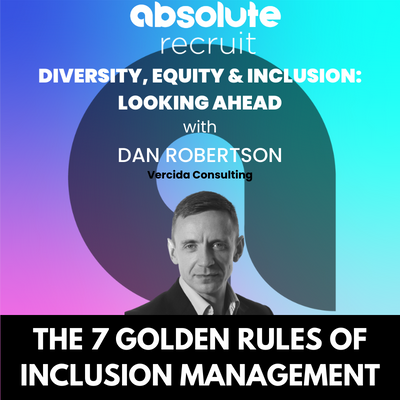



By Dan Robertson
CEO and Founder, Vercida Consulting
Following a recent workshop in partnership with Absolute Recruit, many colleagues asked a series of question on how to embed ED&I in their organisations.
Here are my 7 ‘golden rules’ for building and implementing an effective ED&I Strategy.
Before businesses can set a direct of travel, HR functions need to provide leaders with a business ‘heat map’. This heat map would will be created by collecting, tracking and analysing data on the make-up of your workforce. An effective ED&I ‘heat map’ is created by collecting, tracking and analysing data in key people decision-making areas including, recruitment, work allocation, time with leaders and performance reviews scores. Information should also be analysed based on role, function, pay and reward. This process provides organisations with hotspots of systematic bias. By aggregating data across different diversity groups businesses avoid a blanket labelling based on difference, and instead provide smart data covering a range of groups, such as women, LGBTQ+ community and people of colour. This process also includes conducting diverse pay audits.
Different groups experience bias and exclusion differently. Additionally individuals are also members of multiple communities, we all have a race, gender, sexual orientation etc. Smart organisations use their data to apply an intersectional lens to workplace bias, examining in detail the cross-cutting themes of race, gender, social background, religion, age and other factors. This point is echoed by a close friend and colleague of mine, Fiona Daniels who stresses that “The glass ceiling effect goes hand in hand with systemic racism. This will be different in different countries too especially countries where you are not a minority”. In my work with clients, I often take an intersectional approach when examining talent review processes.
There is much confusion as to the nature of inequity in the UK. A common definition of bias – individual conscious intent – failures to recognise the true nature of systemic and institutional exclusion within UK society as a whole and discrimination at work. Ensure all key business stakeholders attend meaningful education programmes that focus on exploring;
While society at large has to deal with prejudice in all its forms, we, at work, all have a part to play in the way that we can best influence. So, as business leaders of organisations, we need to ensure that we endeavour to be free from discrimination and use our platforms to influence others.
Many UK business have prioritised diversity at the expense of conscious inclusion and belonging. The focus on representation, while good in intent, has, in many ways created cultures of division and separation. The current numbers-based strategy failures to promote psychological safety and cultures of belonging. Businesses should seek to raise the cultural competencies of leaders, HR colleagues and others. To promote inclusive work cultures businesses should;
Rule No. 5: Integrate ED&I through your supply chain
Business leaders should use their financial muscle by driving ED&I through their supply chain. Procurement teams should set explicit criteria for awarding new business contracts and in contract re-negotiations. Examples include working with head-hunters and recruitment companies – insisting on diversity on the final short-lists; driving inclusion when working with a wide range of suppliers from construction companies to those working in the creative industries. Companies awarded contracts based on commitments to ED&I; those who fail to meet stated goals and targets at contract re-negotiation stage, should face financial penalties.
Working under the principle of ‘what gets measured, gets done’, businesses should set public targets for promoting diverse and inclusive workplaces. These targets should cover all areas across the employee life cycle, including recruitment, employee engagement, development opportunities and promotions. To meet these targets business should utilise the Positive Actions provisions within the Equality Act 2010. Other activities include implementing sponsorship programmes and creating a diverse leadership bench. Organisations will need to agree quick win targets as well as more longer-term strategic goals. Targets should be communicated both internally and externally, as public targets increase accountability and act as a motivator for sustainable and long-term action.
Businesses should establish long-term structures for measuring progress against any ED&I strategy. Led by senior leaders, an ED&I Action Group should be established. Representation should include stakeholders from a range of key business functions as well as diverse employees. Effective ED&I action groups should include a ‘devil’s advocate’ – an independent voice whose role is to provide expertise, advice and guidance, as well as scrutiny. Part of the Devil’s Advocate approach would include, for example, representation of diverse colleagues in interview panels. Of course organisations should avoid tokenism in this approach.
Vercida Consulting is a global leading diversity and inclusion management business. They support clients in three key areas of work: ED&I training, strategy development and advisory services.
Get in touch:
LinkedIn: https://www.linkedin.com/in/dan-robertson-b935701b/